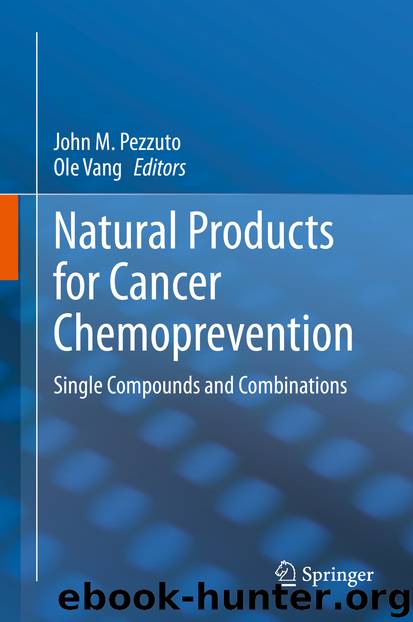Natural Products for Cancer Chemoprevention by Unknown

Author:Unknown
Language: eng
Format: epub
ISBN: 9783030398552
Publisher: Springer International Publishing
10.3 Hepatic and Gut Microbial Metabolism
Dietary polyphenols are generally characterized as xenobiotics with low bioavailability, usually defined as the fraction of the ingested xenobiotic that is absorbed and circulating in intact, non-metabolized form. Many researchers have attempted to link the low bioavailability, often translating into plasma levels in the low nanomolar range, to biological effects in the mammalian host, probably requiring tissue concentrations in the high nanomolar to low micromolar range. The large difference in concentration levels can be attributed to metabolism and accumulation of parent compounds and metabolites in tissues. In the case of dietary polyphenols, it is often not known whether or which metabolites contribute to their bioactivity. In such cases it is advisable to determine a total exposure profile and adjust the bioavailability accordingly. Using this broader definition of bioavailability, Legette et al. (2012) determined the absolute bioavailability of xanthohumol in Sprague-Dawley rats by comparing area under the curve (AUC) after administration of a single intravenous and oral dose of xanthohumol. The authors found that the oral bioavailability of the sum of xanthohumol and its metabolites, calculated as F = (AUCp.o./AUCi.v.) × (Dosei.v. × Dosep.o.), ranged from 0.11 at a human equivalent oral dose of 180 mg to 0.33 at a human equivalent dose of 20 mg. The main compounds detected in the circulation were the O-glucuronides of xanthohumol, isoxanthohumol, and 8-prenylnaringenin (the O-demethylated metabolite of isoxanthohumol). The elimination half-life appeared to be dose-dependent and ranged from 18 to 30 h. The authors repeated the studies in humans taking single doses of 20, 60, and 180 mg by mouth (Legette et al. 2014). In humans, the main circulating flavonoids were the O-glucuronides of xanthohumol and isoxanthohumol, while the levels of 8-prenylnaringenin or its O-glucuronides were either very low or not detectable. The half-life of xanthohumol was about 20 h.
Exposure to hops and its products has been associated with estrogenic effects for over a century. Before mechanical harvesting, hops were harvested manually and women who hand-picked hop cones commonly experienced menstrual disturbances. Early experimental studies to verify the estrogenic activity of hops had variable outcomes: some researchers reported high estrogen activity of hops (Zenisek and Bednar 1960) while others could not substantiate these findings (Fenselau and Talalay 1973). The estrogenic activity of hops could not be attributed to xanthohumol (Verzele 1986). Milligan and coworkers identified 8-prenylnaringenin as the estrogenic principle of hops (Milligan et al. 1999, 2000, 2002). Our research group detected 8-prenylnaringin in beer at concentrations of up to 0.24 mg/L (Stevens et al. 1999b). While these concentrations are probably too low to exert estrogenic effects, isoxanthohumol can be converted metabolically into 8-prenylnaringenin by liver cytochrome P450s (Guo et al. 2006) and by gut microbiota (Bolca et al. 2007; Possemiers et al. 2005, 2006, 2008). Ex vivo incubation of human fecal samples with isoxanthohumol revealed that about 40% of the humans participating in the study possessed a gut microbiome capable of converting isoxanthomumol, the major beer prenylflavonoid [up to 4 mg/L (Stevens et al. 1999b)], into 8-prenylnaringenin (Possemiers et al.
Download
This site does not store any files on its server. We only index and link to content provided by other sites. Please contact the content providers to delete copyright contents if any and email us, we'll remove relevant links or contents immediately.
| Automotive | Engineering |
| Transportation |
Whiskies Galore by Ian Buxton(41935)
Introduction to Aircraft Design (Cambridge Aerospace Series) by John P. Fielding(33085)
Small Unmanned Fixed-wing Aircraft Design by Andrew J. Keane Andras Sobester James P. Scanlan & András Sóbester & James P. Scanlan(32763)
Craft Beer for the Homebrewer by Michael Agnew(18194)
Turbulence by E. J. Noyes(7977)
The Complete Stick Figure Physics Tutorials by Allen Sarah(7334)
Kaplan MCAT General Chemistry Review by Kaplan(6897)
The Thirst by Nesbo Jo(6877)
Bad Blood by John Carreyrou(6581)
Modelling of Convective Heat and Mass Transfer in Rotating Flows by Igor V. Shevchuk(6406)
Learning SQL by Alan Beaulieu(6235)
Weapons of Math Destruction by Cathy O'Neil(6206)
Man-made Catastrophes and Risk Information Concealment by Dmitry Chernov & Didier Sornette(5951)
Digital Minimalism by Cal Newport;(5699)
Life 3.0: Being Human in the Age of Artificial Intelligence by Tegmark Max(5506)
iGen by Jean M. Twenge(5384)
Secrets of Antigravity Propulsion: Tesla, UFOs, and Classified Aerospace Technology by Ph.D. Paul A. Laviolette(5330)
Design of Trajectory Optimization Approach for Space Maneuver Vehicle Skip Entry Problems by Runqi Chai & Al Savvaris & Antonios Tsourdos & Senchun Chai(5036)
Pale Blue Dot by Carl Sagan(4949)
